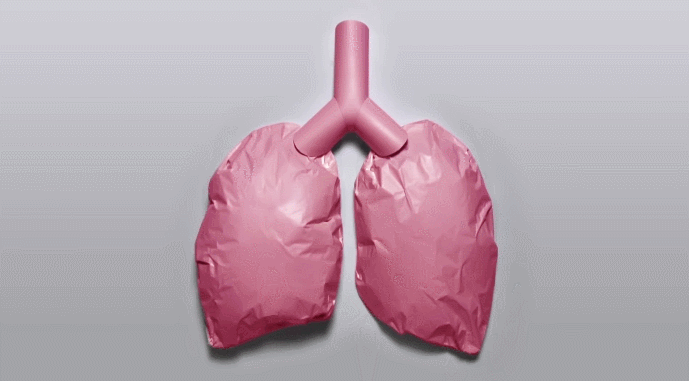China's fight against lung cancer

The artificial simulation image of human lung.
According to statistics released by the World Health Organization (WHO) this February, 8.8 million people were killed by cancer in 2015. Lung cancer patients accounted for 1.69 million of that number, making it the most common cause of cancer death.
Major causes of lung cancer in China
“There are about 4.3 million new cancer patients in China each year, 730,000 of which are lung cancer cases,” Zhi Xiuyi, director and professor of the Thoracic Surgery Department at Xuanwu Hospital Capital Medical University, told CGTN Digital, adding that the morbidity and mortality of lung cancer are both the highest among all the cancers in the country.
Zhi stated five causes of lung cancer in China:
Smoking is a universal cause of lung cancer. According to Zhi, people can calculate their risk of having lung cancer by multiplying the number of cigarettes they smoke per day by the year of their smoking history. If the result is bigger than 400, they are counted in the high-risk group for having lung cancer.
The second cause is air pollution, as smog has become one of the main concerns in society. If the level of PM2.5, which measures atmospheric particulate matter with a diameter less than 2.5 micrometers, in the air people breathe in every day has a concentration that is higher than average, their bodies will be harmed after a fair amount of time.
Oil smoke from cooking is a cause of lung cancer related to Chinese cuisine. Chinese food is famous worldwide, however, some Chinese cuisines are fried or grilled, which creates heavy oil smoke. Zhi claimed that oil smoke from cooking is pathogenic and can lead to respiratory diseases that may be lethal.
Moreover, harmful volatile organic compounds (VOC), such as benzene and methanol, can also lead to lung cancer.
Another cause is anger or negative emotions. Zhi called lung cancer “a disease caused by rage,” saying introversion and sulking are signs of “cancer personality.”
“China’s high morbidity of lung cancer is closely related to the five causes,” Zhi summed up.
Preventing lung cancer
“We need to be cautious about the five causes of lung cancer, especially the middle-aged and elderly people,” Zhi said.
According to the WHO, there are more than 300 million smokers in China, nearly one-third of the world's total. Besides smoking cigarettes directly, second-hand smoke can also be a huge harm to lungs.
To solve this problem, 18 regions in China, including provinces, cities and municipalities, have made regulations to prohibit smoking in indoor public and working areas, in the hopes that creating more smoke-free environments will help regulate smokers.
As for air pollution, Zhi suggests people stay indoors when it is polluted. “If you have to go outside, stay as little time as possible, and use protective measures such as masks that filter PM2.5,” he added, encouraging people to use humidifiers to reduce PM10 and air purifiers to reduce PM2.5 to improve indoor air quality.
To tackle oil smoke caused by cooking, the thoracic surgery doctor hopes people can create “green kitchens” through ventilation and using range hoods. Also, by minimizing frying and grilling.
“We call for ‘green decoration’,” Zhi told CGTN Digital. “People should purchase and use harmless building materials that are certified environmentaly friendly.”
Staying optimistic is also key to preventing not only lung cancer but also other types of cancer, Zhi added.
Early detection and treatment save lives
“Most of the lung cancer patients in China are at terminal stages because people don’t have awareness of early detection,” Zhi said.
In order to raise people's awareness, China plans to promote a lung cancer screening program in more cancer-hit areas in a bid to reduce lung cancer mortality, according to the “Healthy China 2030” proposal issued by the State Council.
By undergoing medical examinations, and getting chest X-rays and CT scans regularly, patients can better their chances of survival. “The mortality of lung cancer in China can be significantly reduced if patients get treatments during early stages,” Zhi said.
China’s progress in fighting lung cancer
China has made great progress in treating lung cancer through independent innovations and technology imports.
“One of the prominent changes in recent years is that China has more and more original drugs,” Zhi said, claiming that the country is also going to lead the world in treatment technologies, such as radiofrequency ablation, microwave ablation and relevant radiotherapy technologies.
Zhi told CGTN Digital that special committees have been set up in the Chinese Medical Association, Chinese Anti-Cancer Association and Cancer Foundation of China, gathering specialists on lung cancer to work together to tackle the problem.
The country has also established a lung cancer database to conduct early diagnosis and early treatment with the aid of artificial intelligence (AI) systems.
In addition, by combining the work of medical associations and anti-cancer associations, especially on prefecture and county levels, China can establish integrated remote consultation centers to provide the most advanced early-diagnosis technology to the patients there.
With increased international exchanges, new technologies have been introduced to China, such as gene detection techniques, clinical applications of robotic surgery, thoracoscopic surgery and AI systems.
As China deals with rising lung cancer cases, these new technologies are expected to make a big difference.
| Chinese Association on Tobacco Control Copyright © 1992-2011 906-907 Anhuidongli, Chaoyang District Beijing 100101 |